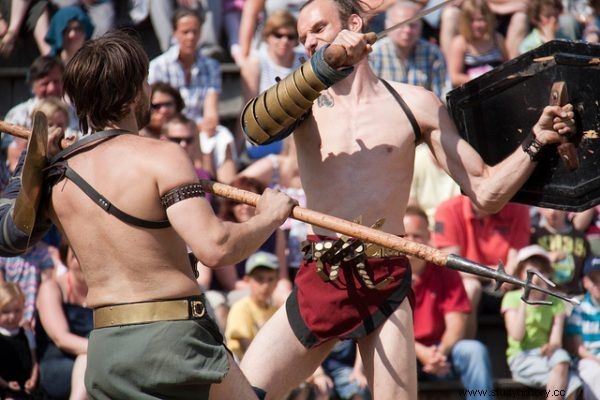Bullying of people and animals. Deadly games and bizarre sports. Pleasing the lowest instincts. Above all, the ubiquitous lust for blood. Until recently, this was how successful fun was imagined.
As always, all TOP10 items are based on the articles we publish. This time we decided to show how much the approach to entertainment has changed over the centuries. And it's definitely for the better…
What a relief it is that today we are not playing:
8. Gladiator fights
The sight of slaves fighting to death in the stadium was in itself the primary entertainment of Roman crowds. The rulers, however, tried with all their strength to diversify this macabre "game". Emperor Domitian showered the audience gathered in the Colosseum with a rain of exotic fruit and rare birds. Favors for gifts, the plebs fought regular battles for them which in themselves could be a predicted attraction.

The gladiatorial fight was surely a lot of fun ... Unfortunately only for the public (photo:Hans Splinter, CC BY-ND 2.0).
Sometimes the execution turned into a sophisticated staging. The opening of the Colosseum was graced with a series of bloody mythological scenes. In one of them, to the crowd's delight, a woman immobilized in a wooden cow was forced to mate with a bull .
It also happened that in the intervals between serious clashes, bows were made to the heavy sense of humor of the Romans. In the times of the republic, slaves came out to the arena, fighting in helmets with blindfolded eyes. The grotesque sight of a group of convicts beating blindly amused the audience (read more on this).
7. Dwarf breeding
Dwarfs have fascinated monarchs for centuries, but they gained particular popularity during the Renaissance. So much so that the French Queen Catherine de Medici reproduced dwarfs like purebred horses. She proudly announced that she pair them up "to breed monsters for admiration for her doctors and the whole environment" . These "little people" were always treated as curiosities and freaks of nature.

The vast majority of known portraits of dwarfs from the modern age come from Spain. We can only imagine Queen Bona's halflings…
They also found their way to Poland in this role. We know about the first dwarfs on the Vistula in the times of Kazimierz Jagiellończyk, but it was probably Jan Olbracht who had his own "pygmy". His brother Alexander had already kept two dwarfs at his court, and a real avalanche of interest in small people fell on our country with the arrival of Bona Sforza.
The queen was also responsible for a new look at dwarfs. Then they played the role of jesters, providing courtly entertainment. The dwarf could also be an expensive gift - Bona sent a pair of halflings to the Habsburg emperor. Her dwarfs, however, also acted as spies, and to one of them the monarch even owed her life (read more about this).
6. Bathing pigeons in perfume
The rich Roman people feasted at the richly set tables in the rooms, stuffy with expensive spices. Nobody was surprised to add them to the dishes. For this astonishment and admiration of the guests was caused by the host, who used pigeons soaked in fragrant oils to spread perfume over the heads of revelers.

There is no good feast without perfumed pigeons ... A Roman banquet on a Pompeian fresco (public domain).
Lucius Crassus, a censor in 92 BCE, decorated his favorite eels with the finest jewelry. The infamous Wediusz Pollion in the days of Augustus fed lampreys with the bodies of slaves .
Compared to this practice, an innocent quirk seems to be the practice of Quintus Hortensius in watering vast tree plantations with wine (read more on this topic).
5. Putting cars on the roof of… a house
New Year's Eve in the nineteenth-century Polish countryside was full of games that can be put aside with relief. Among other things, people used to back up the ladder to the roof of the house to look at the chimney. In this way, it was possible to see the faces of those who were about to die. In Masuria, one brave blacksmith dared to look into the chimney, where he saw himself. After leaving the roof he gave up his ghost immediately.

There is a wagon, there is a thatched cottage ... that is almost everything you need for a crazy New Year's Eve party. A painting by Józef Chełmoński from 1873 entitled "During the rain" (public domain).
As midnight approached, young men appeared in front of the houses and started firing lashes. After this equivalent of fireworks, when the hosts fell asleep, the youth started frolics and mischief. The gates were moved outside the village in a silent manner, cattle were driven to the neighbor's farm, and even carts were placed on the roofs of the houses.
At dawn, such a sight raised smiles on the faces at first, but later caused quite a lot of trouble. The games often ended with considerable losses. The host had to, say, put the roof back up (read more about this).
4. Running a dumb parade
At the turn of the 15th and 16th centuries, the donkey became a synonym of licentiousness. Therefore, he had to participate in mocking rituals. Especially against… slippers.

There's nothing like riding a donkey ... especially when it's a mocking parade. A print by Gustave Doré entitled "Paysan des environs de Madrid" Iic. CC BY 2.0).
When Raymond de Blasy, a Provencal, played cards in a ham in 1762, his wife tried to subtly lure him out of there. Since she failed, she went berserk. She tore the deck of cards, grabbed her husband by the tailcoats and dragged him home by force. Unfortunately for the battered gambler, this was not the end of the humiliation. Witnesses to the incident said they would "ride him on a donkey." And they kept their word.
On Sunday, they put the donkey to run through the countryside. In the parade, he followed a group singing accusations against Raymond from the car. The animal carried a figure symbolizing the slipper, which - to the delight of the crowd - the actor playing the wife threw from the "steed" and hit the distaff (read more on this topic).
3. Freak shows
Mutilation of prisoners of war was a constant part of the medieval strategy of intimidating the enemy. In 1159, one of the knights of Frederick Barbarossa fell into the hands of the crew of the Crema fortress. He was stripped of his arms and legs and made to crawl through the city streets , which aroused general merriment among the inhabitants.

In the Middle Ages and the modern era, the disabled were treated as a source of endless entertainment ... Painting by Pieter Bruegel the Elder "Kalecy" from 1569 (public domain).
The disabled were treated as a source of entertainment not only during the war. Deformed people were a fashionable gift in the aristocracy. They were forced to fight, perform naked, and perform acrobatics. Gentlemen especially appreciated jesters suffering from epilepsy or cerebral palsy. They even hung bells to provoke bouts of illness.
No wonder then that the oldest home for the mentally ill in Europe was able to support itself almost on its own. From the 15th century onwards, paid "insane shows" were organized there, attracting crowds of Londoners hungry for entertainment ... (read more on this topic).
2. Erotic games with the child
The seventeenth-century French dolphin, Louis XIII, the future king, was not yet one year old when a maid amused him to his feet by tickling a bird. For the following years, unaddressed by anyone, he could jokingly touch his genitals. It is hardly surprising, since the nurse and one of my father's lovers eagerly slipped their hands under his shirt.

How different from ours was the approach to child sexuality at the time, let the fact that even in this religious painting from 1570 by Paolo Veronese, little Jesus touches his genitals (public domain).
At the age of five or six, when the adults stopped playing with his royal jewels, he began to play with the genitals of others. He used to play with a maid named Mercier in her bed, whipping her, examining her ass, and even - as he said himself - cunt. He was able to describe her surprisingly accurately:he said that Mercier has such a big cunt (shows two fists) and that there is water inside .
Centuries later it was commented that the "games" had awakened the already grown king's aversion to the fair sex. His upbringing, however, was not as shocking for his contemporaries as it was for us. Sexual jokes and games with children were the norm at the time (read more on this).
1. Public torture and executions
It is hard to find a better entertainment for the crowds in the past centuries than quartering or breaking the wheel in the streets of the city. Particularly spectacular was the quartering with the help of four horses, pulling the still alive condemned man by the limbs in different directions. Sometimes the tearing of the body was only successful after the executioner had cut the victim's body.

17th-century illustration of the quartering of a convict using four horses (public domain).
While breaking with a wheel, a naked condemned man was tied to the ground with his arms and legs stretched out. A piece of wood was placed under each pond. It was there that the executioner hit the wheel, i.e. an angular wooden club, additionally covered with metal. The last experiences of a convict in this world were usually several dozen blows of a 40-kilo device for limbs and chest.
If the unfortunate infidel decided to convert during the process and convert to Christianity, then the executioner would have used the milder version - he would have started the blows by breaking the spinal cord. Then both the convicted person would suffer less, and the execution, to the delight of the crowd, would take the same amount. The executioner would just hit the wheel in the dead body… (read more about this).
